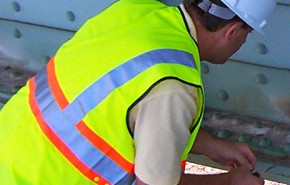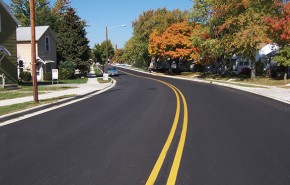We consumers are used to the concept of design-build. Our homes, cars, even mobile devices are all built by one builder, one company. But when it comes to infrastructure projects, design-build takes on a new meaning.
Why Design-Build Makes Sense
![]() As consumers, we live in a world of design-build. If you build a house, you usually pay one builder who provides plans and constructs your home. That new car you just bought? The manufacturer provided both engineering and delivery. Even your latest iPhone is designed and built by a single company that includes both engineers and manufacturing centers around the world.
As consumers, we live in a world of design-build. If you build a house, you usually pay one builder who provides plans and constructs your home. That new car you just bought? The manufacturer provided both engineering and delivery. Even your latest iPhone is designed and built by a single company that includes both engineers and manufacturing centers around the world.
The notion of design-build for infrastructure projects, however, is different. Roads and municipal services are not consumer products, they are vital arteries that feed our population and drive commerce. These projects put safety and durability before profitability. Applying consistent engineering criteria to meet repeatable designs weighs far above the vague similarities between “Brand A” and “Brand B” commonly found on your supermarket shelves.
This ultimate need for owner control over the final product is the genesis of our infrastructure industry, in which:
- Engineers provide owner-directed designs; or
- Independent contractors provide construction in accordance with plans and specifications.
Fortunately, the infrastructure industry has matured. As project criteria become more refined and owners become more sophisticated, engineers and contractors have found good opportunities for design-build delivery. Teaming as one entity under one contract, design-build teams have developed effective methods to ensure that every goal of a project is met without sacrificing safety or quality. Design-build delivery also offers added value to the owner.
Integrated team saves time and money
Conventional design approaches are often formulaic, following a predictable, conservative approach. While using the safe route may result in a quality project that meets requirements, it is not always the most cost-effective or innovative solution. With design-build, an integrated team works with a single focus on getting the job done efficiently and effectively. Design-build saves time and money over conventionally bid projects nearly every time.
- Lower bids, more benefits. Surprisingly, design-build bids are normally lower than the construction-only bids on similar jobs that had full plans provided. This saves the agency money, from engineering fees to administrative oversight. Dollars saved turn into new projects that bring tangible benefits.
- Reduced project time. A conventional design schedule for a typical transportation project may take two to three years before a single shovel can be put into the ground. Developing a design-build concept and procuring a design-build team takes far less time. From there, construction can commence almost immediately as the design-builder quickly moves component plan sets (such as a clearing and grubbing and rough grading plans) into the field.
In the early stages of a design-build project, the team carefully studies available construction areas and Maintenance of Traffic plans, seeking a way to build the project faster and in logical pieces. Months, and even years, can be shaved off projects—saving costs and lessening impacts to road users—a true win-win.
- Tailored design matches means and methods. Integrating the engineer and constructor is invaluable to construction efficiency. Each contractor has unique access to cranes, stockpiles of materials, and a specific way they can expedite construction. The design-build approach allows a synergy between the engineer and construction methods. In contrast, a conventional design project in many cases forces a contractor to build the job using means and methods that are slower and more expensive.
Design-build yields a better mousetrap
The design-build process is the ultimate value engineering study, centered on finding a better way to deliver a project while lessening impacts and costs. Designs must meet contract requirements that are equal or better to the owner’s proposed concept. In this realm, alignments are refined, bridges are shortened, and operations are enhanced—providing the best value to the owner (and ultimately the taxpayer).
Also, most design-build procurements include a “points” component with extra credit given for technical benefits. With this incentive to win, proposers will often enhance their project proposal to provide benefits beyond simple cost savings. GAI has been involved in several projects where a high technical score outweighed the low bidder—allowing citizens to enjoy the benefit of a better project despite a marginal price increase.
Design-build teams manage risk from the start
When large/complex construction projects are bid using the conventional design-bid-build procurement method, they present a great deal of risk for the owner. Millions of dollars in design costs are spent each year on overly-detailed plans in order to avoid additional construction costs associated with unforeseen conditions, quantity overruns, and plan errors and omissions.
Using this procurement method, the owner takes full responsibility for all design details, which by nature cannot be “perfect” or avoid all construction claims. Designers operate independently of the contractor and must anticipate the means and methods needed to complete the project, presenting enormous detail. This typically results in not only large design costs, but also a design that is far from the most efficient or economical—while potentially resulting in construction claims worth millions.
Design-build projects act more like a performance specification—essentially stating that the design-build team provides a finished product that meets the contract requirements. The chances for claims against owners are very small, as the design-build team takes full ownership of all elements of design and construction. Each proposer assesses risks during the technical proposal and bid phase and adjusts their construction bid, as each feels appropriate.
So why don’t we do all projects the design-build way?
The answer ultimately goes back to risk management. The design-build process works extraordinarily well on large projects with a mix of predictable and unpredictable work, where risk can be distributed across a larger budget. It works well, too, on smaller, straightforward projects that have little uncertainty. When a project doesn’t fit either of these categories, a good deal more work must be done up front to clearly iron out critical issues and stakeholder interests.
![]() A good example of this is identification and management of utility conflicts. These co-habitators of Department of Transportation (DOT) Rights-of-Way have rights of their own, and must be given reasonable time and access to adjust facilities as needed. The risk of utilities meeting commitments are difficult for a design-build team to quantify, and addressing these issues prior to advertising a project requires more agency-funded engineering. And, of course, the accommodation of utilities can ultimately define the design and constrain innovation—taking away the key ingredients that drive savings in the design-build approach.
A good example of this is identification and management of utility conflicts. These co-habitators of Department of Transportation (DOT) Rights-of-Way have rights of their own, and must be given reasonable time and access to adjust facilities as needed. The risk of utilities meeting commitments are difficult for a design-build team to quantify, and addressing these issues prior to advertising a project requires more agency-funded engineering. And, of course, the accommodation of utilities can ultimately define the design and constrain innovation—taking away the key ingredients that drive savings in the design-build approach.
The design-build process feeds off innovation and delivers large infrastructure projects around the world. As a leader in design-build projects, GAI partners with contractors and owners throughout our ever-growing geography and continues to be at the forefront of this important delivery method.
![]() Steve Boylan, PE has more than 24 years of experience in design and project management, specializing in the design of major limited access and arterial roadway reconstruction, roadway rehabilitation, and elements of traffic design. He has managed projects throughout Florida ranging from small, meaningful safety improvements to high-density, high impact urban reconstruction projects.
Steve Boylan, PE has more than 24 years of experience in design and project management, specializing in the design of major limited access and arterial roadway reconstruction, roadway rehabilitation, and elements of traffic design. He has managed projects throughout Florida ranging from small, meaningful safety improvements to high-density, high impact urban reconstruction projects.
For more information about GAI’s design-build services, projects, and trends, contact Vice President Kevin Leadbetter, PE at 904.559.8087 or Assistant Vice President Steve Boylan, PE, at 321.354.5661.


